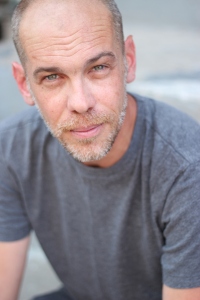Hello once again from Louis Butelli! Here at Folger Theatre we just had a week of technical rehearsals (or “tech”) on Friedrich Schiller’s Mary Stuart. Directed by Richard Clifford and starring Kate Eastwood Norris and Holly Twyford, the show is a tense exploration of greed, lust, intrigue, and revenge. Tickets are on sale: you can get yours by clicking here.
Our rehearsal process shifted focus from the actors to the designers. Our set has two large pairs of sliding doors; our wardrobe, much of which is being custom built, is elaborate; our lighting design must evoke locations ranging from Mary’s prison to Elizabeth’s court to a forest in the English countryside; our sound design must be layered in. These things have taken many hours to perfect during tech, about which I’ll post more once we begin.
Meanwhile, I wanted to take a moment to reflect on the rehearsal process leading up to tech. We spent our first two weeks working off-site at Folger Theatre’s rehearsal studio in the basement of Capitol Hill United Methodist Church. On the floor, our stage manager Brian Sekinger laid down with tape an outline of where various set pieces, entrances and exits would ultimately be. Tables were set up along the downstage edge of the outline, where the front row of the audience would sit, with room for the director, assistant directors, stage managers, dramaturg and any visitors who happened to stop by.
- Assistant Director Cassie Ash, Director Richard Clifford, and Production Stage Manager Brian Sekinger. Photo by Teresa Wood.
- Louis Butelli and Nancy Robinette. Photo by Teresa Wood.
- Kate Eastwood Norris and Paul-Emile Cendron. Photo by Teresa Wood.
- Todd Scofield. Photo by Teresa Wood.
- Todd Scofield, Holly Twyford, and Cody Nickell. Photo by Teresa Wood.
- Rajesh Bose and Holly Twyford. Photo by Teresa Wood.
- Director Richard Clifford. Photo by Teresa Wood.
What happens in these first rehearsals? There are several answers: the actors begin to sketch out characters and relationships, the director shapes their performances, the stage manager keeps copious and frequently-changing notes on actor movement or “blocking,” the dramaturg answers questions of text and/or history, and the fight director has to organize an on-stage scuffle and, (spoiler alert), a suicide.
The central challenge we as actors must grapple with is the performance text, our script. Our day is not done when rehearsal is over. We have to work overnight to master the play’s complex language.
Schiller’s play, as translated by Peter Oswald, is written in heightened language. A fair amount of the script is in blank verse, that is to say un-rhymed iambic pentameter. As with Shakespeare, this means that sentences are long, thoughts are complex and the syntax is tangled. On the one hand, this makes for a beautiful evening of soaring speeches. On the other hand, it is, let’s just say, difficult to learn.
At this point in our process, we are very near to navigating this language with ease. It has been a pleasure to watch as our group of actors transform into the nobility of Elizabeth I’s court. Richard, our director, has been a fantastic ally in this, gently moving the emphasis from one word to another and helping us to use those words to affect each other. The world of the play is slowly but surely coming to life around us.
- Holly Twyford. Photo by Teresa Wood.
- Paul-Emile Cendron and Nathan Winkelstein. Photo by Teresa Wood.
- Kate Eastwood Norris and Holly Twyford. Photo by Teresa Wood.
- Craig Wallace and Cody Nickell. Photo by Teresa Wood.
- The cast of Mary Stuart and Director Richard Clifford. Photo by Teresa Wood.
- Kate Eastwood Norris and Craig Wallace. Photo by Teresa Wood.
- Cody Nickell and Holly Twyford. Photo by Teresa Wood.
Until next time.
Stay connected
Enter your email address to follow this blog and receive notifications of new posts by email.















